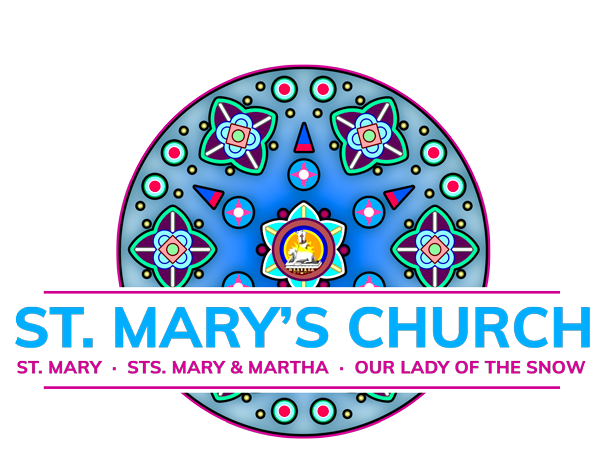A BRIEF HISTORY OF ST. FRANCIS OF ASSISI PARISH
by Father John J. Nacca
1987
The word got around fast. It was 1907 and the Italians of Auburn were overjoyed as they heard the good news. Bishop Bernard J. McQuaid, the first bishop of the Rochester Diocese, had given them permission to build their church.
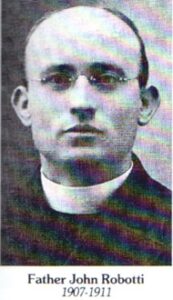
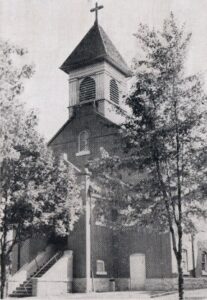
He appointed Father John Robotti of Italy as their first pastor – a young, handsome, fearless priest who supervised the construction of the church at a cost of $17,000! Of course, many parishioners, after a long and hard day’s work in the factories or on the railroad or fields, volunteered their help in building the church. After a hasty supper they would carry on their labor of love, month after month. Yes, that is why the church cost only $17,000.
The church opened in 1908. The first baptism was that of Ida Maria Paolini on January 9, 1908. The first couple united in holy matrimony were Raphael Fiocco and Maria Grazia Carbone on February 9, 1908.
The church was upstairs. The ground floor, believe it or not, would later be our first school. There were 4 classrooms, grades 1 through 4, taught by 4 Mercy Sisters who lived at Holy Family Convent.

It is indeed remarkable that, in those difficult times, when money and jobs were scarce, our pioneering Italians managed to have a school. They had foresight and knew that the best gift that they could bestow on their children was a solid Catholic education that would enable them to overcome the temptations and dangers of later life. May the good Lord reward them for their sacrifices and good sense!
Father Robotti was transferred to Syracuse, where he built Our Lady of Pompei Church, in what is now the largest Italian parish of the Syracuse Diocese. (The present Lady of Pompei Church was built by Monsignor Wash many years later on Ash Street.)
Father Robotti was succeeded by Father Peter Moia on September 7, 1911, also from Italy, who remained at St. Francis until his untimely death on May 1, 1935. During his years of unselfish service, he accomplished so very much. He enlarged the rectory (next to the church); he purchased the land where our present church is located at a cost of $3,000 (an enormous amount when the Sunday collection averaged about %=$35); he paid the current bills from proceeds of spaghetti suppers, etc. He was far-sighted and knew that some day a bigger church would be built. He knew that God would call him before tht dream would come true. With characteristic generosity, he thought of future generations, and that is why, after great sacrifices, he purchased the ground where the new church would someday rise.
His death was a shock to everyone because he was only 49 and had seemingly been in good health. There was a much older priest in Rochester who knew Father Moia well. They were close friends. Never did this priest imagine that he would succeed Father Moia. This Rochester priest, Father Adolph Gabbani, had started the parish of St. Francis of Assisi and built the lovely little Italian church on Whitney Street. He was sure that he would spend the remainder of his priestly days there. But one Saturday morning, on the way to Sears Department Store, he realized that he had forgotten the measurements for some flooring that he wanted to buy. He returned to the rectory and upon entering, was told by the housekeeper that Bishop Edward Mooney (later Cardinal of Detroit) had called on the phone. Father Gabbani had no idea whatsoever as to what the bishop might want. He listened in disbelief when the Bishop said, “Father, I want to ask a favor of you. This is not a command; I’m asking for a favor. Won’t you take over St. Francis of Assisi parish in Auburn?”
Because he had started the parish in Rochester, Father Gabbani was very fond of it, and very much attached to it. He asked for a little time to think matters over. His priestly loyalty and spirit of obedience prevailed, and he followed the bishop’s gentle request.

He spent the rest of his 14 years here. Although elderly and plagued with illness, he was a prodigious worker. By sound management, he saved some money for the new church, even though he must have realized that he was sowing the seed, and others would reap the rich harvest. What nobility of character he and Father Moia showed as they planned and saved for a church that they would never see!
Father Gabbani built, at his own personal expense, a room that connected the second floor of the rectory with the church. This was very helpful, especially when the weather was inclement. Because the rectory and the church were now “one” building (thanks to the room that served as a link), the people on Sunday morning, could tell what the priests would have for the Sunday noon meal because the rich aroma of Italian food (the best in the world) would rise from the kitchen to the second floor of the rectory, through the connection room to the church and to the nostrils of the worshipers.
Weakened by old age, and exhausted by hard work, Father Gabbani, who by this time was Monsignor Gabbani, died at Mercy Hospital on Easter Sunday, April 17, 1949.
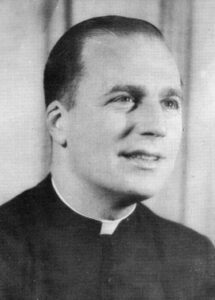
Bishop James E. Kearney appointed Father John J. Nacca, assistant pastor of St. Francis Xavier Church in Rochester, to succeed Monsignor Gabbani on July 4, 1949. Having been assigned to the church twice before as assistant to Monsignor Gabbani, he knew the people well; whom he has consistently and publicly referred to as “the very best in the diocese.”
Upon appointed, he was told by Bishop Kearney that the parish needed a new church and a school, but the bishop specified that he wanted the school first.
One of the very first things that the new pastor did was to call the bishop’s office and obtain permission to increase the insurance on the church property, which was $64,000, far below the actual value of the property.
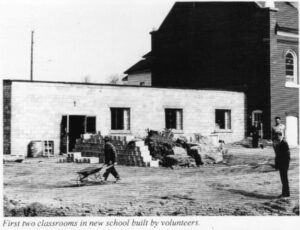
The days of 1907 came to life again. Volunteers came for months after their day’s work to clean, repair, and modernize the church, rectory and grounds. These men also built the so-called “glass corridor” that would later house the first and second grades of the school. It was an inspiring sight to see these men working until ten o’clock at night and later, night after night, then father for a snack, plan the work for the next night and leave. Indeed, they wrote a glorious chapter in our parish history.
We must mention here our volunteers for the spaghetti suppers, the unrivaled minstrel shows, and bazaars. Our bazaars were the best attended because the food was delicious, the bands were enjoyable, with their folk and martial music, and the fireworks were simply spectacular. No other parish offered so much. There was very much work in planning and conducting the bazaars but the biggest, hardest, most tiresome job was the cleaning up when it was all over. The grounds, on the day after, looked as if the city rubbish heap had been struck by a cyclone, earthquake and tornado, all at the same time. You had rubble and rubbish and trash and shards of glass and litter all over the lot. A well-meaning parishioner told the pastor that, in order to save himself time and effort, he should borrow a hose from the firemen and flush everything into one corner., where it would be easy to gather. The hose was borrowed, the pastor held it gingerly in his hand thinking that it was a garden hose. Someone turned on the water from the hydrant and the water dished forward with such breathtaking speed, force and pressure that the pastor also was thrown forward (very awkwardly) and it was he, not the rubbish, that was washed and pushed in to one corner.
And how about those other volunteers, the bingo workers? Week after week they gave up one evening for the wearisome job of calling out numbers and supervising and dealing with players, a few of whom (not all, just a few) whose combined refinement and culture, if put on a scale of 1 to 10 would be 0.
Whether it was the bingo workers, when the school was new, or the workers of later days, we owe so much to these men who did their job so quietly, patiently and faithfully; and brought in many thousands of dollars for the church.
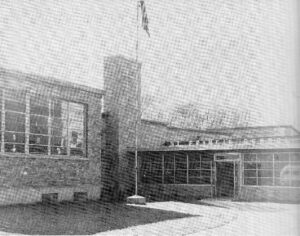 In 1950 the cornerstone was laid for the school. Children from the kindergarten to the eighth grade would be welcome. The first graduation was in 1952.
In 1950 the cornerstone was laid for the school. Children from the kindergarten to the eighth grade would be welcome. The first graduation was in 1952.
A home to serve as convent for the nuns was purchased shortly before the school opened. When no longer needed, it was sold to Dom Vasco at 6 Brookfield Place.
It is interesting to know that when Mt. Carmel High was being built, there were several delays in construction, and the students who had planned to enter the first year at Mt. Carmel were told, much to their disappointment, that the school would not be ready for that September. The parishioners of St. Francis, with typical kindness and generosity, came to their assistance. The pupils were told that they would be welcome to have their first year high at St. Francis School, free of charge. So, you might say, Mt. Carmel High School started at St. Francis.
The enrollment at St. Francis School (now, we’re talking about our grammar school) was very high. When the new West Genesee School was built, it declined somewhat, but our school, with its enrollment of 520, even at the time of its closing, was not a small school by any means. We had 13 teachers, 8 of whom were lay teachers.
The nuns were known as RJM, Religious of Jesus and Mary. About 5 months before the school opened in September of 1951, the pastor went to see Monsignor Mahoney, the Superintendent of Catholic Schools on the Diocese of Rochester. What a shock to the pastor when he was told that there were no nuns available to staff our school! The shortage of nuns was already critical way back in 1951, 36 years ago. The pastor asked Monsignor Mahoney where he could go to get some nuns to teach. “honestly, Father, I have no idea whatever” was the discouraging and heartbreaking reply.
Of what good is a school without teachers? And so, the pastor tried the different orders of nuns between here and Albany. Everyone he received the same discouraging and crushing reply, “Father, we don’t have enough nuns to staff the schools where we already are. How could we assume a new responsibility?” From New York State to Massachusetts, the pastor went, begging in vain and then to New Hampshire.
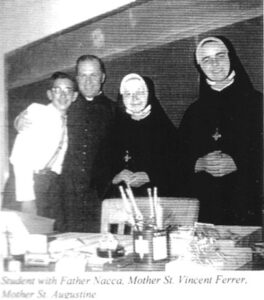 The Sister Provincial of the Religious of Jesus and Mary was a saintly old nun, who must have been in her upper 80s. thin as a pencil, with a whitish, pallid, anemic face. The pastor often referred to her as the holiest-looking person that he had ever seen.
The Sister Provincial of the Religious of Jesus and Mary was a saintly old nun, who must have been in her upper 80s. thin as a pencil, with a whitish, pallid, anemic face. The pastor often referred to her as the holiest-looking person that he had ever seen.
When she saw him, tired and worn out, with a film of dust on his clothing from the long ride, she asked him if he wanted a glass of ginger ale, while a young nun stood next to her. “Sister,” he said, “I want something better.” Her holy eyebrows went up a notch, in pius amazement, thinking that he wanted a drink with high alcoholic content. By “something better” he meant nuns.
“I feel sorry for you, Father, said the kindly old nun “and I’ll help you.” Immediately the young nun interrupted with, “But Sister, we can’t do that. We’re suffering from a terrible shortage.” The ensuing few moments were the longest and most agonizing in the pastor’s life. “I know about the shortage,” said the Provincial, “but I feel sorry for Father. I’ll help him. We’ll start him off with 5 nuns.” And that’s how our school started, with the help of God and that saintly old nun in far-way Goffstown, New Hampshire.a
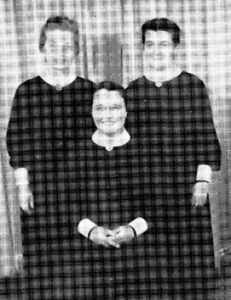
We shall always remember, with heartfelt gratitude, the good Trinitarian nuns who, before our school was built, served our parishioners for many years by giving the children religious instruction; by visiting and consoling the sick; by enlightening darkened souls, and by inspiring the lagging ones. Their rules state that they are to carry out their sacred work in disadvantaged parishes that are understaffed and unable to have a school. But because these nuns had a strong affection for St. Francis Church and for the children, they made a temporary exception to their rule, and taught for a few years in our school, together with the Religious of Jesus and Mary. Later, when Sister Provincial deemed it necessary to relocate the nuns because our parish had a school and was progressing very well, the pastor went to the Motherhouse in Philadelphia in an effort to keep these dedicated sisters longer, but the Sister Provincial felt that in conscience she should abide by the above-mentioned rule, and soon afterward transferred the nuns to less fortunate parishes.
The school turned out first-rate students who had received an excellent religious training as well as a first-class education in the secular subjects.
By the early ‘70s the shortage of nuns had reached the critical stage. The Religious of Jesus and Mary, because of the shortage, were faced with the problems of having to close one school – either St. John’s in the Bronx with 1200 pupils, or St. Francis School in Auburn with 520. The new Mother Provincial, also very good and deeply religious, came in person to tell the pastor that she had to make the very distress choice. To close the smaller school ws the lesser of two evils. She mentioned how good the children and parents of the parish were. She also said that her nuns wanted to come to St. Franci because the saying had got around:” Go to St. Francis and see the world.”
The school buses were as much a part of the school as were the classrooms. The children who lived beyond a certain point received free transportation to school in the morning and back home in the afternoon. And, speaking of free, no child ever paid a penny for school tuition. The generous parishioners, at great personal sacrifice, made it easy for every child to get a sound Catholic education. If some child could not afford to pay for the books, that also was taken care of, absolutely free.
The bus drivers were volunteers who deserve a special place in God’s immortal Roll of Honor. The children attending public schools were also bussed free for their weekly religious instruction.
There is nothing romantic or glamorous about driving a school bus. But the drivers were a happy group, who remained undaunted by the weather, the traffic, and the deafening noise of a busload of children trying to outshout each other. The drivers had a feeling of satisfaction. They knew that they were driving children close to school and close to God.
The bus trips were very many, to points of religious, historic and scenic interest. They were not only recreational but also educational. And everything was free! On many occasions, the nuns from other schools would join our children as guests. The other parishes would borrow our buses from time to time to bring their children to some amusement park or basketball game. Whenever graduates of St. Francis school meet, one or another of them will start a long conversation with the reminiscent words, “Remember the time when we went on the trip to _________?”
 The school cafeteria served complete, well-balanced meals for only 25 cents! (Needless to say, the school made no profit from those meals.) The favorite was cut ziti with meat balls, and salad and bread, and milk – all for 25 cents. The pastor’s mother, of happy memory and his sisters, Mrs. Philomena Buttarazzi, donated years of service to the children in the cafeteria. It is not easy to feed hundreds of children, day after day, and then leave everything spotlessly clean. They also donated their time at the Shrine, where Philomena, during the peak tourist season, would sometimes be busy until midnight. This donated work brought in money that helped pay off many church bills.
The school cafeteria served complete, well-balanced meals for only 25 cents! (Needless to say, the school made no profit from those meals.) The favorite was cut ziti with meat balls, and salad and bread, and milk – all for 25 cents. The pastor’s mother, of happy memory and his sisters, Mrs. Philomena Buttarazzi, donated years of service to the children in the cafeteria. It is not easy to feed hundreds of children, day after day, and then leave everything spotlessly clean. They also donated their time at the Shrine, where Philomena, during the peak tourist season, would sometimes be busy until midnight. This donated work brought in money that helped pay off many church bills.
The Shrine in honor of Our Blessed Lady was built while the school was under construction, and is, by far, the largest in the Diocese.
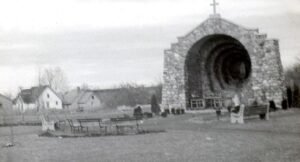
Here, again, there was volunteer labor, and the Shrine was completed in 9 months for only $19,000. The offerings for candles from the faithful in Auburn and from the tourists, together with the sale of religious articles, paid for the Shrine in 9 months. Because U.S. 20, the cross-country highway, passed in front of the Shrine, thousands of tourists stopped each year. It was an edifying sight to see some 18-wheel truck stopping in the middle of the night, the husky driver hurrying to the Shrine, kneeling and praying; then back to the road. Did he pray for his sick child? Or for an ailing mother? Who knows? But we can be sure that Our Blessed Lady heard and helped.
The generous people of the parish contributed to Mt. Carmel High School, and then gave again, when it was enlarged. The grand total was in the neighborhood of $135,000 ($1,583,891 in 2025).
In the early 50’s the old church could no longer accommodate the large crowds. The basement hall was converted into a devotional and cozy chapel where 3 Masses were said each Sunday, in addition to the 4 in the Church upstairs. To preach at all 7 Masses (as was sometimes necessary, and as was done for 9 consecutive Sundays prior to breaking ground, for the new church) was quite a fatiguing task.
In April 1958, construction of the new church began and the first Mass was the midnight Mass on Christmas of that year. The total cost was $375,000. With their usual generosity, the people had set aside a sufficient amount to start the project. In 7 short years the church was completely out of debt.
The parishioners were overjoyed when the first Mass was celebrated, but the happiest of all were the old men who pointed to the old church across the street and said, with choking emotion, “I helped build that one also.”
It must be said, to the credit of the magnanimous people of the parish, that they purchased the home that serves as the present rectory. The land next to it belong to Paul Vitale, of happy memory, who donated it to the church as a parking lot. The old home that was right next to the creek (remember?) was purchased and then demolished to expand our parking zone. The parishioners also purchased the land across from the church, which is now the Columbus Park with the additional parking area behind it.
It is no idle boast but the mere statement of truth when we say that, in generosity toward the missions, St. Francis Church is by far the front runner in the entire diocese.
Just as Father Moia and Monsignor Gabbani saved money for a church that they would never behold, the kind-hearted people of St. Francis built seven churches in far-away lands that they would never see, but the Divine Accountant does see and does know about these churches and we can be sure that the names of the generous givers are inscribed in gold letters in His eternal ledger.
There were 3 churches built in S. Vietnam, 3 in India and 1 in Africa by the mission-minded parishioners. The bishop of the churches in India and the bishop of the church in Africa came in person to thank our very kind people.
The warm-hearted faithful also contributed enough money to put 17 young men through the seminary on their journey toward the priesthood. The was their “gift of gratitude” to Almighty god – sending laborers to work in His vineyard of souls.
We mention also the $12,000 Jeep Rover to the Redemptorist missionaries in Paraguay. This serves as a means of transportation for the priests and brothers over the rough and jagged terrain that would cripple the ordinary car. It serves as an ambulance and mobile pharmacy.
The driving force behind all these noble deeds of charity is the sincere love of neighbor founded in God’s example and in His command, “Love one another.” It is love that disregards all local and national boundaries. It is love that extends beyond the farthest horizons and embraces all people – even though in the remotest corners of the world.
The impressive, life-size statue of Christopher Columbus, facing the church, is of Italian marble, and with a certain measure of truth, we can say that the parishioners of St. Francis gave Coumbus another trip over the same ocean that he had travelled away back in 1492. The statue was blessed in the presence of a large crowd of parishioners, friends, and civil officials. Everyone was overjoyed when U.S. Senator “Al” D’Amato paid us a surprise visit (only the pastor and his nephew, Dr. Patrick Buttarazzi, knew.) In his inspiring speech the Senator commended our people for their tribute to Columbus and their forefathers.
The plaque below the statue tell it all:
“This monument honors Christopher Columbus, our first immigrant, and all our immigrant parents and grandparents, who, by their prayers, hard work, and perseverance fashioned a great nation out of a vast wilderness. God grant that we imitate their virtues, especially their love of God and love of country.”
There are many human-interest stories, and it is difficult to decide which to tell. Here is one of them: Around 1950, Mr. Anthony Contiguglia, who was the Corporation Counsel for the city, and a parishioner, called the pastor on the phone and said, “Father, that parcel of land next to the church (the old church) between the church and Brookfield Place does not belong to the church. It will go on auction tomorrow at City Hall. Be here tomorrow at 1 P.M. without fail. I’ll be here to help you. You should bid for it before someone else gets it.”
In consternation the pastor replied, “Anthony, what are you talking about? That’s like saying that the front yard of your house does not belong to you. The land you’re talking about, just next to the church has been ours since 1907, hasn’t it?”
“No, it hasn’t. It never was, even though everyone thought it was. It’s not in the name of the church. Tomorrow it will be sold at auction for unpaid taxes.”
The next day, in fear and trembling that someone would bid higher than he, or would get the land on some legal technicality, the pastor went to City Hall where he was met by Mr. Contiguglia.
A well-dressed young man of about 30 was there also. He approached the pastor and asked, “Father, are you here for that parcel of land next to the church?”e
“Yes, I am. And why are you here, my good man?”
“For the same land, Father, but seeing that you’re interested in it, I’ll back out.”
“And what business are you in?”, asked the pastor.
“I sell used cars.”
The parish owes a debt of gratitude to the late Anthony Contiguglia and to his alertness in detecting the predicament. Certainly no one would have liked to see, right outside the church, a gaudy sing framed by flashing light bulbs, with the loud exhortation: “Buy Your Rest-Free Used Car Here.”
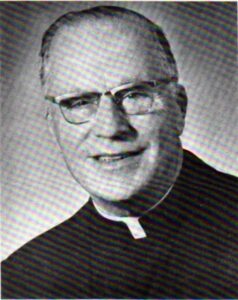 In 1985, Father Nacca reached the mandatory age of retirement and was succeeded by the kindly, hard-working, deeply spiritual Father Patrick w. Seelman, T.O.R. who has made it clear that his motto and rule of life is “Ora et labora” – Pray and Work.
In 1985, Father Nacca reached the mandatory age of retirement and was succeeded by the kindly, hard-working, deeply spiritual Father Patrick w. Seelman, T.O.R. who has made it clear that his motto and rule of life is “Ora et labora” – Pray and Work.
The exterior improvements already made and are about to be made are proof of his progressive and tireless spirit. But far more important is the zeal and fervor of this single-minded priest who has the firm conviction that our interior, spiritual improvement must always be our main concern and goal in life: The Rosary at the shrine every Sunday evening in summer; the Exposition of the Blessed Sacrament every First Friday of the month; his fervent and intense preaching of the Word of God – all these and more are proof of his great love of God and complete dedication to souls.
(Text written in 1987 by Rev. John Nacca given to Paul Saltarello by the Buttarazzi family.)
Pastors
- John Robotti, May 15, 1907-Sep. 1911
- Pietro G. Moia, Sep. 1911-May 1, 1935
- Adolph L. Gabbani, May 3, 1935-Apr. 18, 1949
- Francis H. Turner, 1943
- John J. Nacca, 1949-June 1985
- Francis W. Seelman TOR, June 1985-June 25, 1991
- John F. Gagnier, June 25, 1991-Apr. 28, 1993
- Robert L. Beligotti, June 29, 1993-Nov. 30, 2000
- Peter Deckman, Nov. 13, 2000-June 25, 2002
- Peter J. DeBellis, June 25, 2002-June 27, 2006
- Eugene Dobosz, June 27, 2006-June 30, 2009
- Gary DiLallo, June 30, 2009-June 24, 2014
- Frank E. Lioi, June 24, 2014-present
